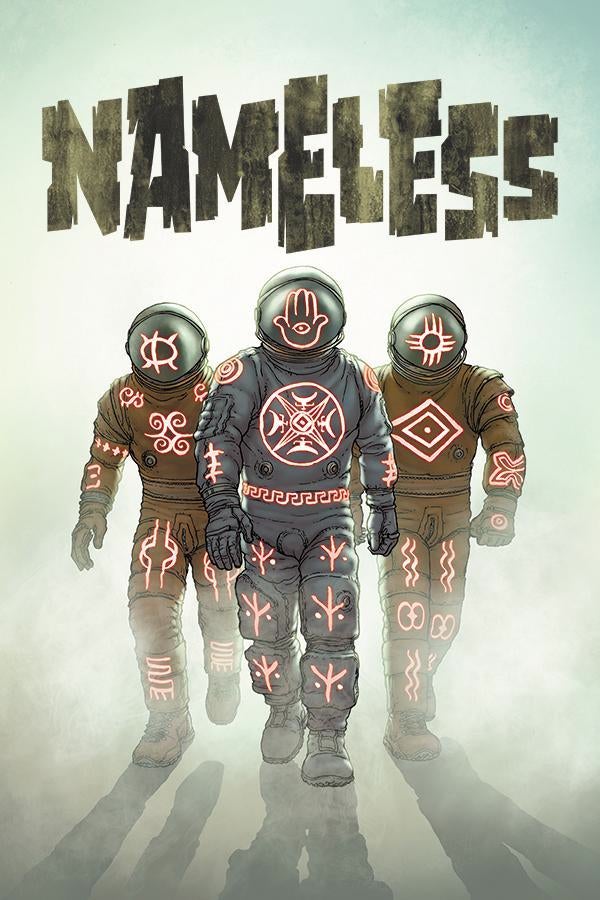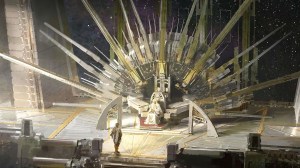Nameless #1 centers on an occult expert without a name, or rather one called Nameless due to his lack of a name. He is revealed in media res jumping through dreams in an attempt to steal the key to the empty box from Nan Madol or “The Empty Spaces”. It’s every bit as layered and mystifying as it sounds. That sense only increases when a greater conspiracy is revealed that pulls the earth and moon into the stories’ orbit. However bewildering the ideas and plot of Nameless may seem on the surface though, it shouldn’t be enough to deter readers. This is a Grant Morrison comic after all and the story may resemble a Gordian knot on its surface, but it is of a purposeful design that can be undone without a sword. The inclusion of two of Morrison’s greatest collaborators, Chris Burnham and Nathan Fairbairn, ensures that the design and meaning of Nameless can be discerned by readers who care for more than the most standard of comics fare.
Videos by ComicBook.com
Nameless #1 may be referred to as horror or a psychedelic thriller, but it defines genre definition. The story ignores tropes and simply does as it pleases. There are references and comparisons to be made, but they are keys to understanding the story rather than its basis. They are simply a description of a comic that incorporates whatever elements are necessary in order to convey meaning.
Again, that is not to say Nameless is indiscernible or confusing. While it is certainly dense, it is not difficult to recount the basic structure of the plot and characters involved. Mapping the actions of each page and how they connect can be done easily enough. Discerning the meaning of these actions and their connections is where readers must become very active participants in the story. Morrison crafts both micro and macro stories within Nameless #1. In a micro story, readers are shown brief anecdotes of the atrocities being committed on earth. Only a few panels encapsulate entire happenings. The macro story is that of Nameless and the conspiracy in which he finds himself entangled. It is within the balance of the greater narrative and the micro-narratives that Morrison creates a complete world where both parts reflect and impart meaning upon one another.
The exploration of that meaning is where Morrison’s comics truly come to life because they are so filled with referential material that touches upon the comic itself, outside context, and Morrison’s previous work. Something special happens in the panels and sequences, where these references merge in order to force reader to consider the significance of what they are reading. Something like Pure Morrison Magic.
The final panel of page 11 shows an eel twisting in blood-soaked water. In that one image Burnham evokes multiple meanings challenging the reader to dissect both the panel itself and how it reflects upon Nameless’ story within the comic. The eel is twisted in the shape of an eight with its mouth and tail almost meeting at the crux point. It is the infinity symbol, a centerpiece to Morrison and Quitely’s masterpiece Pax Americana #1. The eel’s mouth is open and approaching the tail prepared to swallow it and create the form of an ouroboros. This is not only a figure central to Morrison’s extensive run on Batman, but connects to Mayan mythos revealed later in the issue. Both the infinity symbol and ouroboros are symbols of the endless nature of existence wherein destruction and rebirth are part of an ongoing cycle. Beyond that, the head and tail are made to resemble the male and female genitalia drawing forth ideas of reproduction and opposite halves forming a whole.
Within a single panel, Morrison and Burnham construct an image that adds multiple layers of meaning to the work that surrounds it and this is far from a lone example within Nameless #1. Even details like the name Paul Darius begs readers to assess whether the connection to historical figures like Paul the Apostle and King Darius I bears significance.
The thing about Morrison comics is that they are often defined by the collaborators involved. Nameless #1 is not a resounding success because of Grant Morrison; it is a resounding success because of Grant Morrison, Chris Burnham, and Nathan Fairbairn. Burnham and Fairbairn are two of the absolute best creators to ever collaborate with Morrison, and it is because of their involvement that this debut issue manages to evoke meaning and resonate so clearly.
Burnham crafts Nameless #1 to have a very confined feel in which both Nameless and the reader are stuffed into the dream settings. The walls of a cube lock in Nameless and condense the page with three visible side pressing in upon the center of the panels. Burnham also applies his sense of exaggerated realism, creating a sweaty, vigorous energy in the characters. Stubble and unkempt hair define Nameless. He is a figure of magic, but it is a very organic, human magic. This natural feeling keeps with the visceral emotions and responses of the stories, turning the fantastical into something biological.
Burnham’s panel compositions in Nameless are truly something to behold. Through the first half of the comic he injects sigils into the pages. These symbols are highlighted by Fairbairn’s coloring and construct a world where magic lies beneath the lives and actions of the people involved. It is a constant, undeniable presence.
In a page towards the end of the issue, Burnham composes a page with three globes, one in the center and two halves at the top and bottom. They reflect the globe-like device projecting the image of the powerful Paul Darius, as well as the two orbs central to the plot: the earth and the moon. Between the top and bottom halves of the page, Burnham inverts the same image of Nameless and Paul, showing how the information revealed in the center literally flips his world upside-down. It is another example of Pure Morrison Magic, in which a single construct bears multiple meanings in and beyond the context of the story.
Fairbairn’s colors accentuate the claustrophobia and tense world constructed by Burnham. Inky shadows and oppressive darkness leak from the edges of panels in an attempt to consume the figures of the story (reflecting the literal shadowy consumption of Earth shown in a dream). Nameless #1 is not entirely composed of dark palettes though, far from it. Fairbairn infuses neon displays of violet and lime green into the issue. He illuminates dreams with a fierce energy that is every bit as threatening.
When you combine the talents of Morrison, Burnham, and Fairbairn, what you are left with is magic. It’s primal and raw, certainly not pretty, but undeniably powerful. They have stuffed the pages of Nameless with ideas and meaning, building a story that is constructed like clockwork, but still breathes and moves like a living thing. It is instinctive and intellectual, merging feeling and meaning into a story that challenges your mind while thrilling your senses.
Grade: A-









